Learn how to make this soft and chewy gluten free bread recipe! It’s easy to make without too many ingredients and too many complicated steps. If you’ve been missing bread in your gluten free diet then look no further with this recipe!
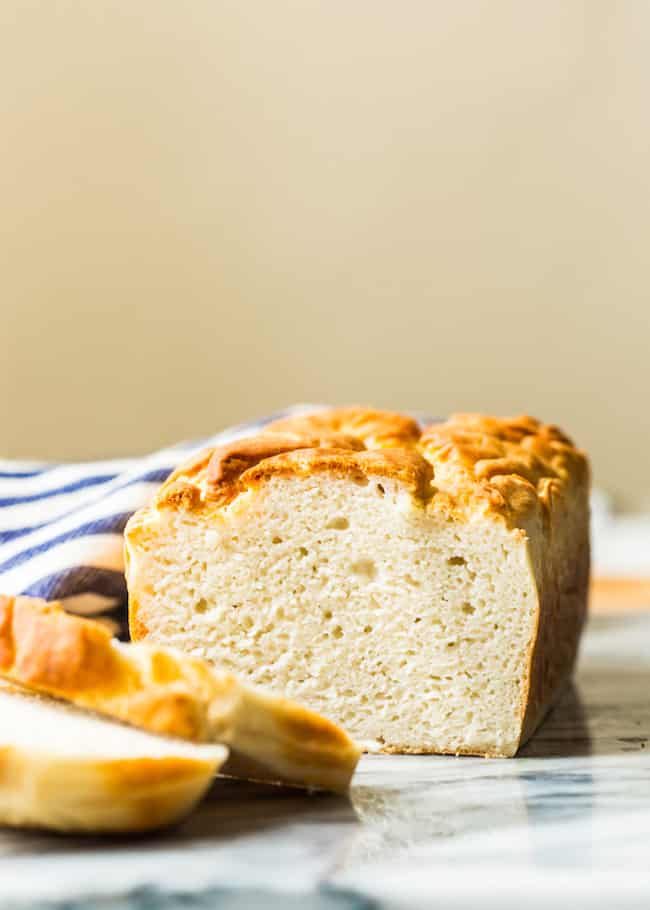
Bread
Who doesn’t love it? Fresh out of the oven, crusty, artisan bread slathered with butter, or drizzled with olive oil? Gimme all the bread.
It’s the perfect accompaniment to pretty much any main dish while also being just as satisfying on its own.
It’s also the destroyer of diets with its carb filled goodness and an actual source of pain for the millions of people who are afflicted with Coeliac Disease or gluten intolerances. Historically, gluten free breads have been…well…sad. Dry, crumbly, tasteless, not to mention expensive. Thankfully, as time goes on and the demand for gluten free products increases we’re getting better at making do sans gluten without compromising taste and texture.
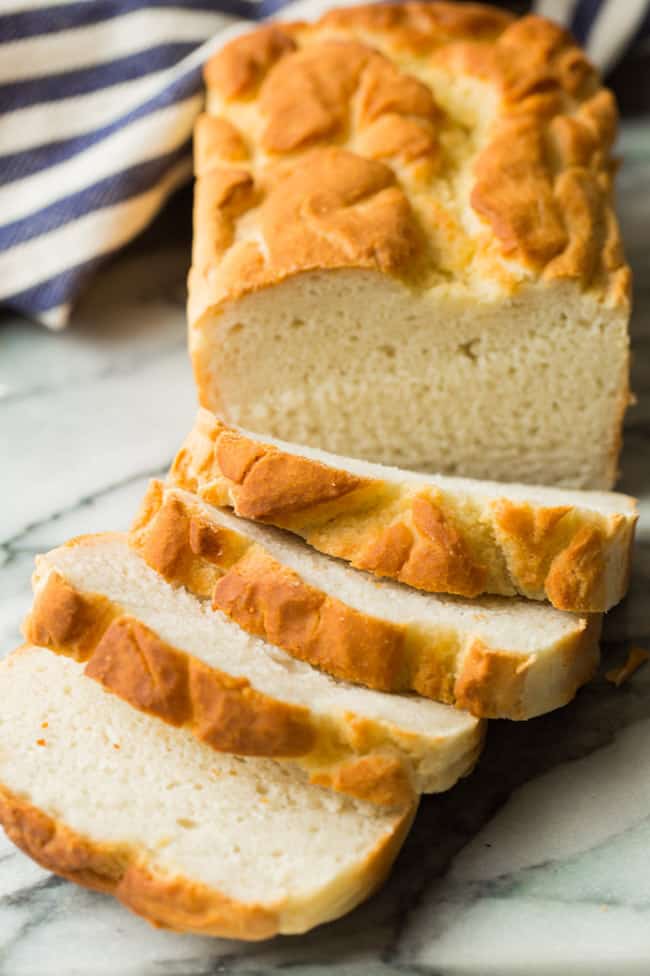
Homemade Gluten Free Bread Recipe
Altogether this bread is made up of about 10, fairly basic ingredients without too much effort.
Unlike a lot of really great gluten free recipes this bread only requires two different types of flours: rice and tapioca. Since I first made this bread years ago rice & tapioca flour have become one of my favourite combos whenever I’m looking for an easy GF flour blend (like in these Yorkshire Pudding).
Yeast Prep Steps
- Whisk together most of your dry ingredients: flours, salt, xanthan gum and baking powder. Set that bowl aside.
- Dissolve the sugar in warm water.
- You want your water to be warm to the touch, but not hot. Too hot and the heat will kill the yeast which will prevent the bread from rising.
- Stir in the yeast and then let the mixture sit aside for about 5-10 minutes as the yeast foams up.
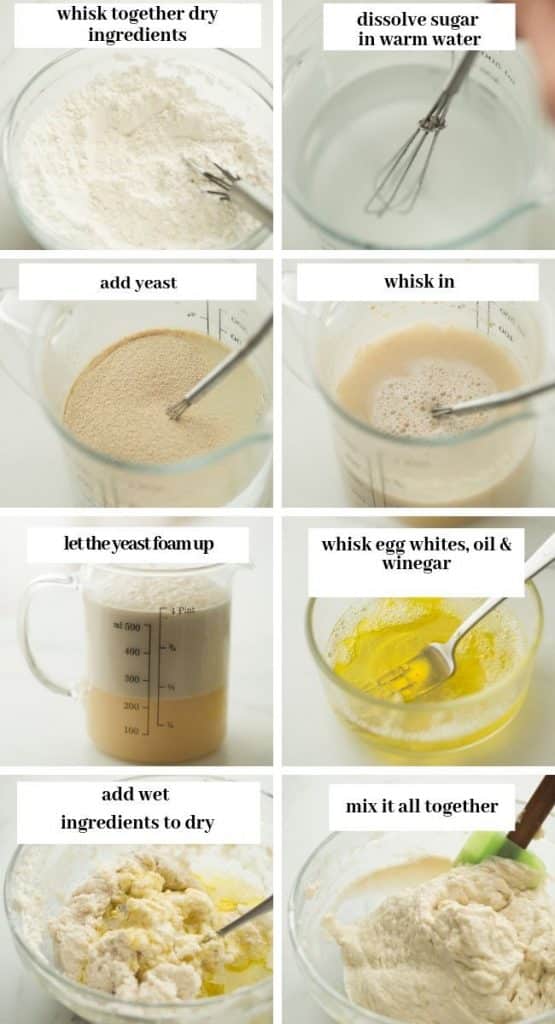
Dough Steps
- Whisk the eggs, oil and vinegar in another small cup or bowl. You don’t need to mix too much, just enough to get the egg whites slightly foamy.
- Add the yeast-mixture and the oil-mixture to the flour mixture and combine.
- The dough is going to look very wet and very unusual. As long as you mix until no lumps of flour remain you’re alright.
- Spoon the batter into a prepared loaf pan, cover and set aside in a warm place. Let rise at least 30 minutes. The bread should have risen by at least 30%.
- Place in the preheated oven and bake for 35-40 minutes. Let cool for at least 15 minutes and then enjoy!
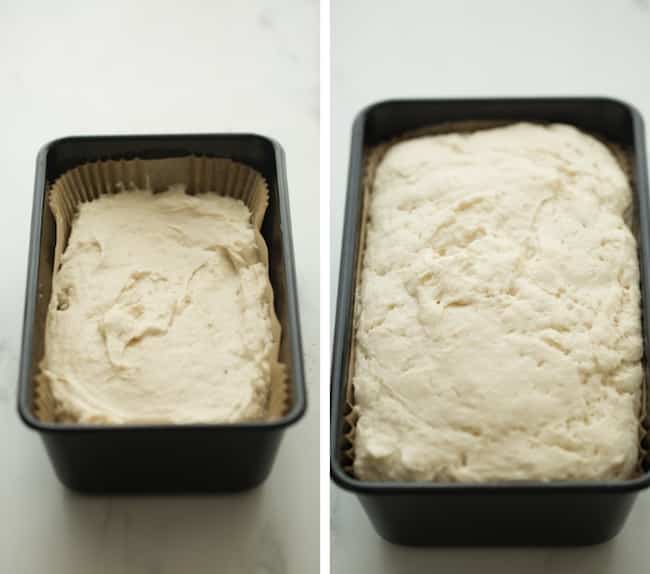
Tips
- Since there is no gluten to over work, don’t be afraid of mixing this bad boy up. If you have a stand mixer, that’s perfect. If you don’t have a stand mixer, give yourself a good arm workout and put some elbow grease into it. I tried this out with an electric handheld mixer, and while it did eventually work, I wouldn’t use it again because my dough kept getting stuck.
- The fully mixed dough will look very wet. The first time I made a gluten free dough, I was concerned I had messed up somewhere along the lines because my dough was sticky, wet, and needed to be spooned into my bread pans.
- I find this to be true with baking in general, but especially when working with yeast please make sure to use room temperature ingredients so that the yeast has the opportunity to rise properly.
Can I Make this Egg Free?
Yes! I have a Gluten Free Vegan French Bread recipe you can make! Instead of egg whites, that recipe uses aquafaba (the goopy liquid found in cans of beans). Weird, but it works!
Can I use different flours?
- You can use brown or white rice or a combination of the two.
- You can use arrowroot starch in place of tapioca flour.
- Beyond those changes I haven’t played around much with other types of flours. I do think you could probably use potato starch as well in place of the tapioca but I can’t say for sure yet. I am currently working on a grain free/paleo bread so stay tuned if you’re interested in something like that. (Update: Everything Bagel Almond Flour Bread)
Do I have to use xanthan gum?
Xanthan gum does a couple of things in this recipe: it helps hold on to moisture (something gluten free goods are often desperate for) and provides added structure which is something that gluten would normally provide. Without xanthan or some kind of binder gluten free goods can be dry & crumbly.
If you can’t buy or use xanthan you can use guar gum instead. Both of these can usually be found in the baking or gluten free section of major grocery stores. If all else fails you can always find these on Amazon.
Why didn’t my yeast mixture foam up?
Your water was too hot or too cold. Too hot will kill the yeast and too cold it won’t fully activate.
Your yeast is already dead. Yeast has a shelf life of about 4 months. It can last longer than that but there’s no guarantee. If it’s been awhile since you last used it you may need to buy more.
Can I use sugar substitutes or leave out the sugar all together?
The sugar helps us to see that the yeast is working as it’s what makes it foam up. It’s not actually 100% necessary for the bread, though a little sugar does help with the flavour. If for whatever reason you can have or don’t want to use sugar just leave it out.
- Sugar subs like erythritol & swerve won’t work for the yeast.
- Honey, maple and coconut sugar all work.
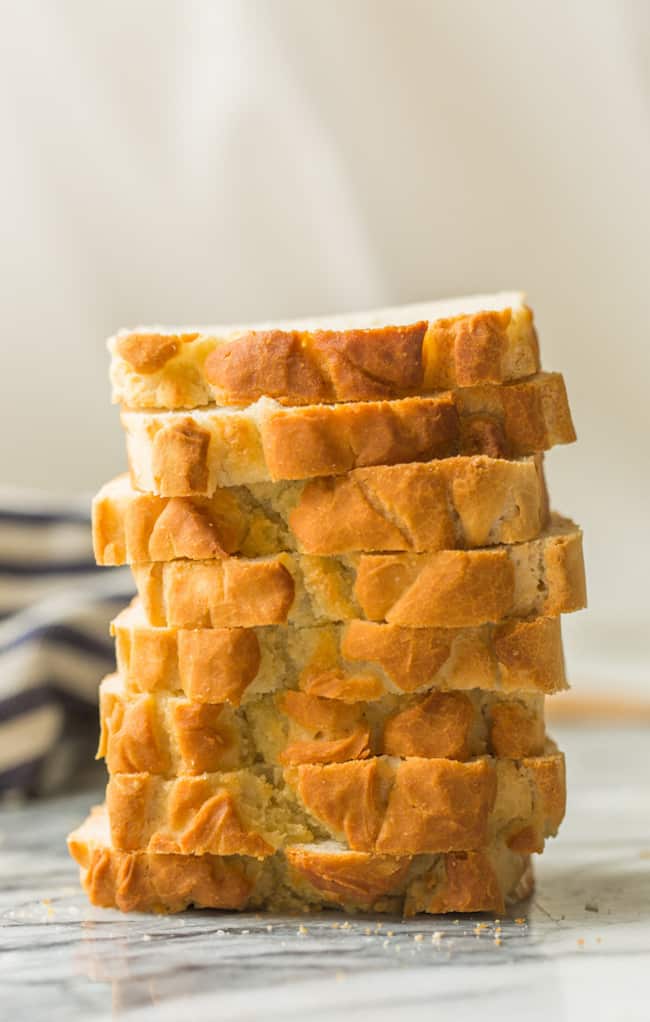
If you have any more questions please let me know in the comments below!

Easy Gluten Free French Bread
Learn how to make this soft and chewy gluten free bread! It's easy to make without too many ingredients and too many complicated steps. If you've been missing bread in your gluten free diet then look no further with this recipe!
Ingredients
- 2 cups rice flour (white or brown) (280g)
- 1 cup tapioca flour (100g)
- 2 teaspoons xanthan gum*
- 1 tablespoon gluten free baking powder
- 1 teaspoon salt
- 1 1/2 cups lukewarm water, (360ml) between 105-110 degrees F, 40-43C
- 1 tablespoons gluten free quick rise yeasts
- 2 tablespoons sugar
- 2 tablespoons olive oil
- 3 egg whites, lightly beaten
- 1 teaspoon apple cider vinegar (you can substitute for another vinegar if you don't have ACV
Instructions
- Whisk together your flours, xanthan gum, salt and baking powder.
- In another bowl or jug mix together hot water and sugar. Stir until your sugar dissolves then add the yeast. Let the yeast foam up for a few minutes.
- While the yeast is foaming up, beat together your three egg whites slightly. Mix in the oil and vinegar.
- Pour the yeast mixture to the flour mixture along with the eggs and mix it all together. Make sure to mix everything until no lumps remain.
- Grease or line 2 (8x4 inch) loaf tin or one french bread pan and spoon your batter into each tin. Cover and stash in a warm place for at least 30 minutes. I like to stow my dough in the microwave or a warmed but off oven for rising process because it keeps my dough free from drafts and disturbances.
- After your dough has risen by about 30% (about 30 minutes) preheat your oven to 400°F/ 200°C. Place in the middle and bake for 35-40 minutes, turning the dough about half way through for an even bake.
- Remove from the pan and cool on a wire rack for at least 15 minutes until you're ready to slice and serve.
Notes
Recipe lightly adapted from Food.com
Can I make it egg free?
- Yes! You can find the egg free/vegan version of this bread by clicking through to the link here.
Can I use different flours?
- You can use brown or white rice or a combination of the two.
- You can use arrowroot starch in place of tapioca flour.
- Beyond those changes I haven't played around much with other types of flours. I do think you could probably use potato starch as well in place of the tapioca but I can't say for sure.
Can I use sugar substitutes or leave out the sugar all together?
- The sugar helps us to see that the yeast is working as it's what makes it foam up. It's not actually 100% necessary for the bread, though a little sugar does help with the flavour.
- If for whatever reason you can have or don't want to use sugar just leave it out. Sugar subs like erythritol & swerve won't work for the yeast.
- Honey, maple and coconut sugar all work.
Do I have to use xanthan gum?
- Xanthan gum does a couple of things in this recipe: it helps hold on to moisture (something gluten free goods are often desperate for) and provides added structure which is something that gluten would normally provide. Without xanthan or some kind of binder gluten free goods can be dry & crumbly.
- If you can't buy or use xanthan you can use guar gum instead. Both of these can usually be found in the baking or gluten free section of major grocery stores. If all else fails you can always find these on Amazon.
Nutrition Information
Serving Size:
1 Calories: 115Total Fat: 2gSaturated Fat: 0gTrans Fat: 0gUnsaturated Fat: 2gCholesterol: 0mgSodium: 174mgCarbohydrates: 22gFiber: 1gSugar: 2gProtein: 2gMore gluten free bread recipes you might enjoy:
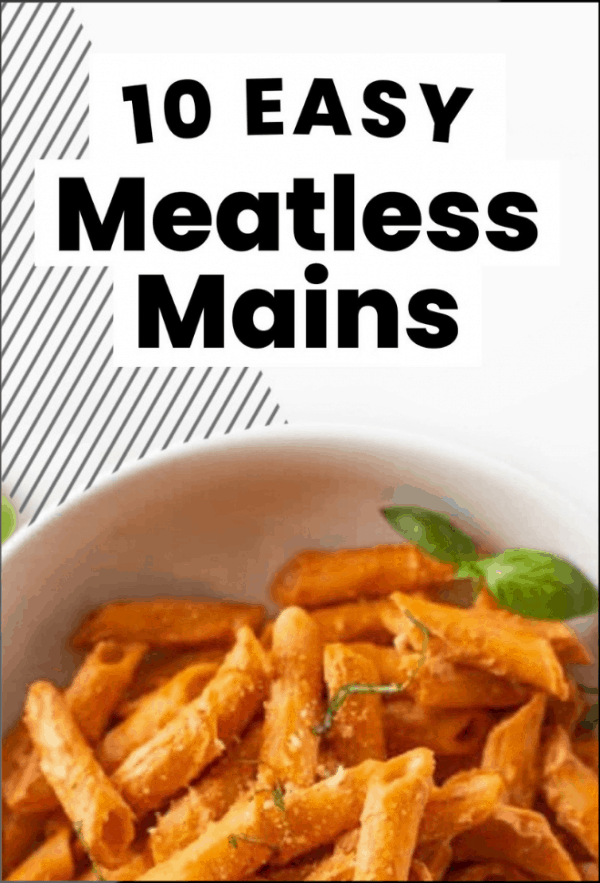

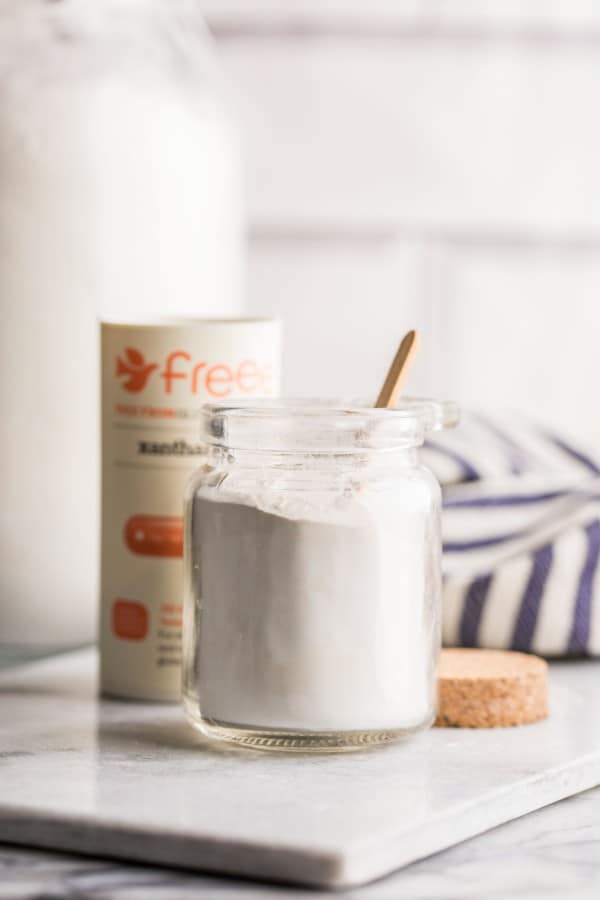
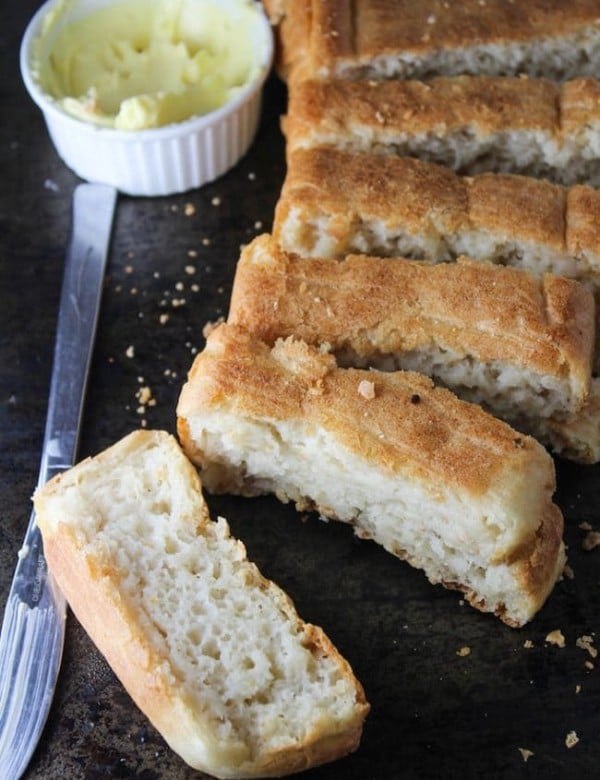
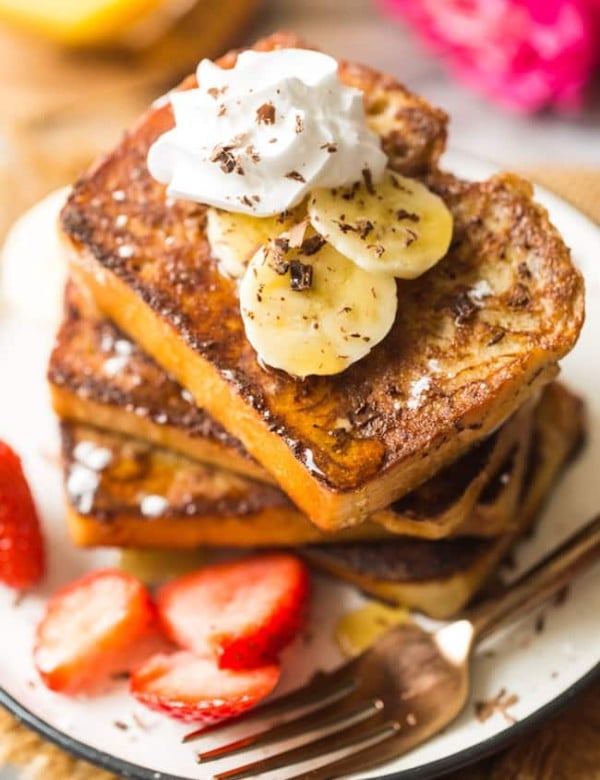
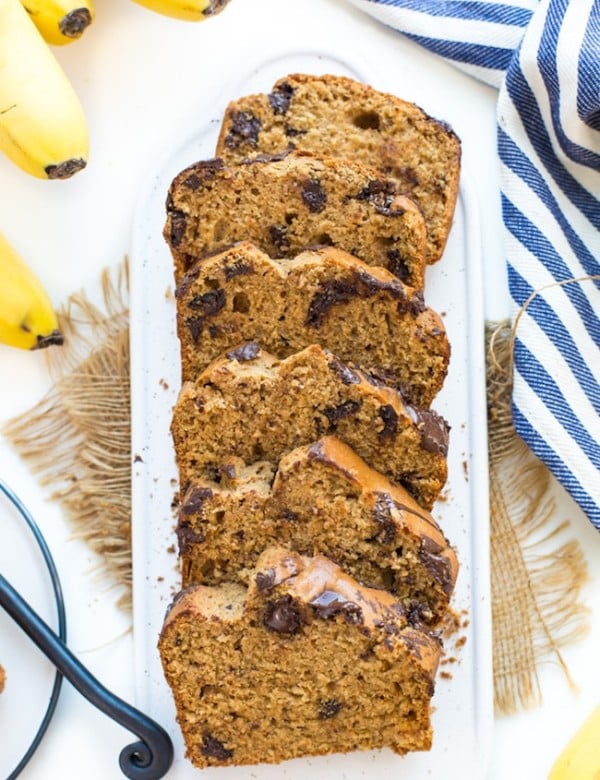
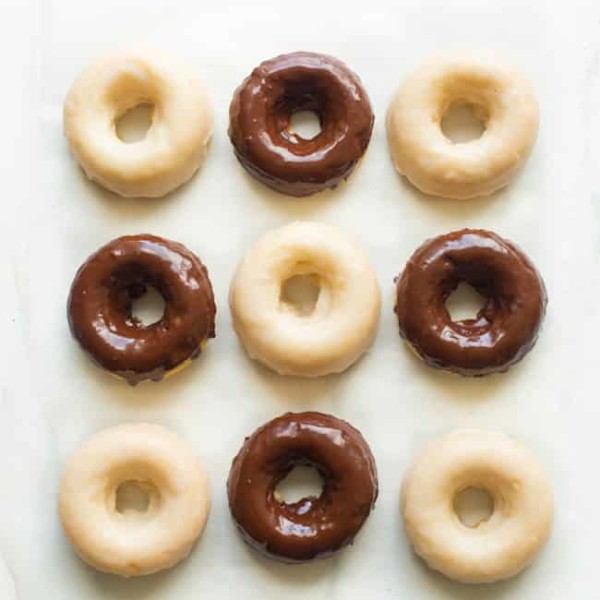
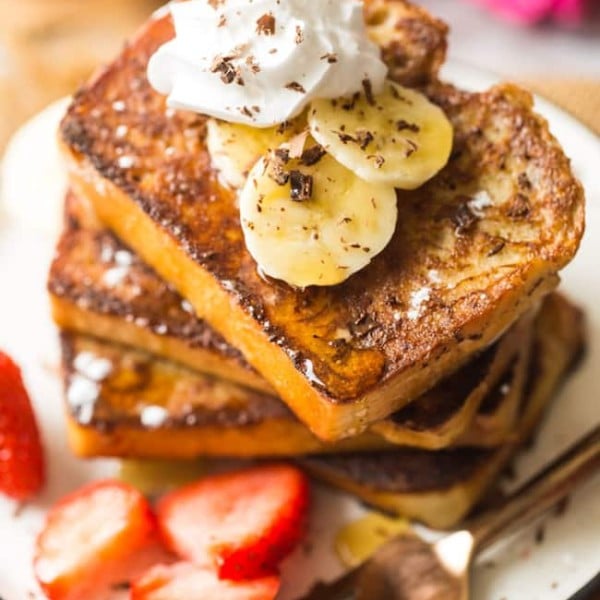
Linda says
Can you make this French bread with other flours, like Coconut or Almond flour?
Sarah says
Hi Linda! Almond & coconut flour react so differently from these flours so I wouldn’t know how to change the amounts of things to work here. If you’re looking for a grain free/paleo french bread you might like this one here http://cookituppaleo.com/paleo-french-bread-cassava-flour/
Avi says
Before starting to make this bread, I read the recipe a million times. When I finished making the dough, the dough looked more like a cake batter, so I am quite nervous it will not be good and I would have just wasted all the ingredients. Time will tell if it’s good.
Sarah says
That bread sounds right so far! That’s why I say in the recipe to scoop the batter into the bread pan – it feels strange but just keep with it!
Ann Everett says
After the rising period and I carefully placed it in the oven, the loaves collapsed. It tastes wonderful and the texture is great but I don’t feel that I was completely successful because it doesn’t look so pretty.
Sarah says
Oh no! I wonder if the loaves might have risen too much – that’s usually one of the reasons why breads collapses during or after baking. Glad you still liked it even though it didn’t come out right!
Mandy says
This Bread is amazing! So light and soft. I am excited to make it again. Have you made it with any modifications? Ie brown rice flour? I’m so happy that I tried this recipe, thanks for sharing it.
Sarah says
Thanks Mandy! So glad you liked it! I have tried it with brown rice flour and I couldn’t really tell much difference and I’ve also made an egg free version of this too. Other than that I haven’t wanted to change much since I really enjoy it as is
Mandy says
Great thanks Sarah, I will try it with brown rice flour too. I can’t say how excited I am about this bread, it was soooo good!
Dani says
I’m intolerant to tapioca. Is there anything that could be substituted? Would cornstarch work? Or potato starch? Any ideas?
Sarah says
I’ve never tried it with any of these substitutes so I can’t say for sure but I think you might be able to get away with using arrowroot or potato starch without too much difference. I’m not positive about cornstarch – my understanding is that when it comes to baking with cornstarch you use about half the amount of cornstarch as you would other types of flour so I’m not sure how much that would change the recipe. I hope that helps!
Laura says
Perhaps oat flour or coconut flour?
Sarah says
I haven’t tired any of those with this, but I think they’d be too dry. Coconut flour is extremely absorbent so you’d need to change up the liquid amounts to make these work
Angela Hoy says
I ran out of rice flour so substituted with some coconut flour, worked fine.
Rachel says
This bread is amazing! I love that I have found a recipe that meets all my food allergies that I can make on my own and stop spending $5-10 a loaf from someone else! However, a few questions – I’ve made this bread twice and today was more successful than the previous attempt, but I did notice a few of the same issues. The dough seems rather chunky, although it’s just the outside that remains chunky after baking. Is this because I mix by hand as opposed to a mixer? I know I’m not mixing “on high for 3 min”, but I am mixing it enough to blend it. Also, my bread isn’t fluffy, it’s light and delicious right when it comes out, but it doesn’t seem to get the air pockets that normal bread gets. I’ve tried using my own baking powder (every baking powder that I have access to has corn starch it, and I’m allergic to corn, so I’ve been doing 1/4 tsp baking soda and 1/2 tsp of apple cider vinegar (this equals 1 tsp of baking powder). The first time I did that and the 2nd time I doubled the amount and didn’t notice too much of a difference. I’m also curious about the amount of yeast. I’ve been told from wheat flour using bakers that 2 tbsp is a lot of yeast and that the bread should be light and fluffy with that amount. I let the yeast mixture rest for about 10 minutes today (as opposed to the 5 min the first time), and again, not too much of a difference. Any suggestions??
Sarah says
Hi Rachel! SO glad that you like the recipe! I’ll try my best to help you out here. As for the chunkiness, I’m not entirely sure I know what you mean by that. Are you talking about the smoothness of the bread after baking? I know the dough for this is a lot more batter like – if it’s baked without being smoothed down in places it can look a little chunky in some areas. It doesn’t really affect the taste, but it might not look as good. If that’s the case, just put a little oil on the back of a spoon and use that to smooth down the sides before baking.
As for the the fluffiness, I think this is just one of those things that often gets lost when baking gluten free bread. To be honest I’ve never had a piece of gluten free bread (store, bought, homemade, or from a bakery) that I would say it comparable to regular gluten free in terms of lightness. As good as they may be, without the gluten creating nice little air pockets everywhere, it’s just not exactly the same. That’s why there’s more yeast in this recipe that you’d normally see in wheat based recipes. Since we’re working at a disadvantage here by not having gluten – the key protein that usually makes light and fluffy bread that also rises – the extra yeast is to give us a little more edge here.
I hope that helps answer some of your questions, but please ask away if I didn’t quite cover it here!
Rachel says
That does help! I have had two gf breads that are light and fluffy, so it is definitely possible (somehow!). But your pictures show light and fluffiness whereas mine didn’t quite get that airy.
That is sort of what I mean by chunky – I’ve tried to smooth it out, but it didn’t quite work. I got the impression it might need more liquid, since the dough was just so sticky and I couldn’t get it smooth. I was afraid to add water to the dough in case it ruined the entire thing!
Becky says
Rachel did you use psyllium husk powder? I did, and my dough was SOOOO ‘chunky’ that I couldn’t spread it. I read in one of the comments on this thread that you should add 1T water for each teaspoon of PHP, so I took the lumpy dough out of the pans and stirred in 3 T of water. That helped SO MUCH!!!! The bread is fabulous, but would have been awful if I hadn’t happened to have read that.
Mrs G says
This is the best bread ever! I’m really happy with the recipe. I avoid making it too often because I can eat it by myself in just one day! I love the crust, super crunchy in the cast iron pan, and the inside is really soft! We love it!
Sarah says
I know what you mean! This never lasts more than a few hours when I make it so I always make sure I’ve got people to share with otherwise 🙂 I’ve never though to put it in a cast iron pan before – I’m going to do that next time! Thank you!
Vicki says
Hi thanks for taking the time to share your great recipes! Can I ask though when you say to beat the egg whites slightly, how slightly do you mean? Are we talking soft peaks or not that much? Thanks
Sarah says
Hi Vicki! You only need to beat them enough to make them a little bit foamy on top with a few bubbles on top. Hope you like the bread!
Jess says
Excited to try!!! I only have Brown rice flour….will this be ok? Or could I use almond, coconut, or all purpose GF flour? Also, in my stand mixer should I use regular beaters or my dough ones? Thank you so much in advance
Sarah says
Brown rice flour is totally fine! I use that sometimes instead of white if I’m ever out. I’d also recommend using the regular beaters since the batter is usually really wet before baking. Hope you like it as much as we do!
tina says
Has anyone tried this recipe with cup4cup flour or any of there other ready made gluten free sp flours?